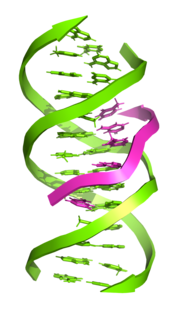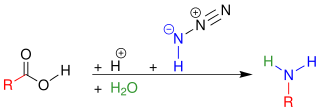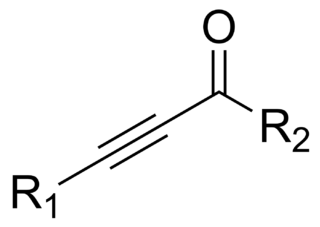
Ebonite is a brand name for very hard rubber first obtained by vulcanizing natural rubber for prolonged periods. Besides natural rubber, Ebonite contains about 25–80% sulfur and linseed oil. Its name comes from its intended use as an artificial substitute for ebony wood. The material is known generically as hard rubber and has formerly been called vulcanite, although that name now refers to the mineral vulcanite.
Lactones are cyclic carboxylic esters, containing a 1-oxacycloalkan-2-one structure, or analogues having unsaturation or heteroatoms replacing one or more carbon atoms of the ring.
Isomerases are a general class of enzymes that convert a molecule from one isomer to another. Isomerases facilitate intramolecular rearrangements in which bonds are broken and formed. The general form of such a reaction is as follows:

Cellobiose is a disaccharide with the formula C12H22O11. Cellobiose, a reducing sugar, consists of two β-glucose molecules linked by a β(1→4) bond. It can be hydrolyzed to glucose enzymatically or with acid. Cellobiose has eight free alcohol (OH) groups, one acetal linkage and one hemiacetal linkage, which give rise to strong inter- and intramolecular hydrogen bonds. It can be obtained by enzymatic or acidic hydrolysis of cellulose and cellulose rich materials such as cotton, jute, or paper. Cellobiose can be used as an indicator carbohydrate for Crohn's disease and malabsorption syndrome.
In chemistry, homolysis or homolytic fission is chemical bond dissociation of a molecule by a process where each of the fragments retains one of the originally bonded electrons. During homolytic fission of a neutral molecule with an even number of electrons, two free radicals will be generated. That is, the two electrons involved in the original bond are distributed between the two fragment species. The energy involved in this process is called bond dissociation energy. Bond cleavage is also possible by a process called heterolysis.

Triple-stranded DNA is a DNA structure in which three oligonucleotides wind around each other and form a triple helix. In triple-stranded DNA, the third strand binds to a B-form DNA double helix by forming Hoogsteen base pairs or reversed Hoogsteen hydrogen bonds.
A cascade reaction, also known as a domino reaction or tandem reaction, is a chemical process that comprises at least two consecutive reactions such that each subsequent reaction occurs only in virtue of the chemical functionality formed in the previous step. In cascade reactions, isolation of intermediates is not required, as each reaction composing the sequence occurs spontaneously. In the strictest definition of the term, the reaction conditions do not change among the consecutive steps of a cascade and no new reagents are added after the initial step. By contrast, one-pot procedures similarly allow at least two reactions to be carried out consecutively without any isolation of intermediates, but do not preclude the addition of new reagents or the change of conditions after the first reaction. Thus, any cascade reaction is also a one-pot procedure, while the reverse does not hold true. Although often composed solely of intramolecular transformations, cascade reactions can also occur intermolecularly, in which case they also fall under the category of multicomponent reactions.

The Pauson–Khand reaction is a chemical reaction described as a [2+2+1] cycloaddition between an alkyne, an alkene and carbon monoxide to form a α,β-cyclopentenone. The reaction was discovered by Ihsan Ullah Khand (1935-1980), who was working as a postdoctoral associate with Peter Ludwig Pauson (1925-2013) at the University of Strathclyde in Glasgow. This reaction was originally mediated by stoichiometric amounts of dicobalt octacarbonyl, but newer versions are both more efficient and catalytic.

In chemistry, aurophilicity refers to the tendency of gold complexes to aggregate via formation of weak metallophilic interactions.

Hydrastine is an alkaloid which was discovered in 1851 by Alfred P. Durand. Hydrolysis of hydrastine yields hydrastinine, which was patented by Bayer as a haemostatic drug during the 1910s. It is present in Hydrastis canadensis and other plants of the Ranunculaceae family.

The Schmidt reaction is an organic reaction in which an azide reacts with a carbonyl derivative, usually a aldehyde, ketone, or carboxylic acid, under acidic conditions to give an amine or amide, with expulsion of nitrogen. It is named after Karl Friedrich Schmidt (1887–1971), who first reported it in 1924 by successfully converting benzophenone and hydrazoic acid to benzanilide. Surprisingly, the intramolecular reaction wasn't reported until 1991 but has become important in the synthesis of natural products.
In enzymology, a lysolecithin acylmutase is an enzyme that catalyzes the chemical reaction
In chemistry, a metallophilic interaction is a type of non-covalent attraction between heavy metal atoms. The atoms are often within Van der Waals distance of each other and are about as strong as hydrogen bonds. The effect can be intramolecular or intermolecular. Intermolecular metallophilic interactions can lead to formation of supramolecular assemblies whose properties vary with the choice of element and oxidation states of the metal atoms and the attachment of various ligands to them.

3-Hydroxyflavone is a chemical compound. It is the backbone of all flavonols, a type of flavonoid. It is a synthetic compound, which is not found naturally in plants. It serves as a model molecule as it possesses an excited-state intramolecular proton transfer (ESIPT) effect to serve as a fluorescent probe to study membranes for example or intermembrane proteins. The green tautomer emission and blue-violet normal emission originate from two different ground state populations of 3HF molecules. The phenomenon also exists in natural flavonols. Although 3-hydroxyflavone is almost insoluble in water, its aqueous solubility can be increased by encapsulation in cyclodextrin cavitiies
Autotransporter proteins are proteins secreted out the Gram-negative bacteria. These beta helixes require a domain which is called the intramolecular autochaperone domain. It shows similarities with other intramolecular chaperone sequences and has a folding-associated function. This increases the efficiency, either by stabilizing the beta-barrel, or by promoting the folding of the passenger domain.

2,6-Dihydroxybenzoic acid is a dihydroxybenzoic acid. It is a very strong acid due to its intramolecular hydrogen bonding.

In organic chemistry, an ynone is an α,β-unsaturated ketone with the structure R1C≡C‒C(=O)R2 (R2 ≠ H) in which the carbonyl (C=O) function is conjugated to a C≡C triple bond at the α,β position. Capillin is an example of a naturally occurring ynone.
Excited state intramolecular proton transfer (ESIPT) is a process in which photoexcited molecules relax their energy through tautomerization by transfer of protons. Some kinds of molecules could have different minimum-energy tautomers in different electronic states, and if the molecular structure of minimum-energy tautomer in the excited state is proton-transferred geometry between neighboring atoms, proton transfer in excited state can occur. The tautomerization often takes the form of keto-enol tautomerism.









